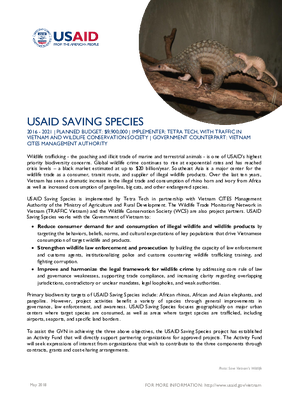Project Spotlight: Vietnam's Saving Species Activity

Author(s): TETRA TECH , TRAFFIC Vietnam , Wildlife Conservation Society , Government of Vietnam
Publication Date: 2018
Location: Vietnam
DOWNLOAD FILESaving Species is USAID/Vietnam’s flagship implementation vehicle for combating wildlife trafficking. Saving Species utilizes a theory of change approach for its three objectives of demand reduction, strengthening law enforcement, and improving the legal framework for wildlife crime.
Vietnam is a Tier One country under USAID’s Biodiversity Policy, a U.S. Government (USG) priority country in the Trans-Pacific Partnership (TPP) for combating wildlife trafficking (CWT) interventions, and a priority country for the Presidential Task Force on Wildlife Trafficking. It is the principal destination and transit country for illegal African rhino horn and elephant ivory and is a transit and source country for the illicit poaching and trade in tigers and pangolins. Demand for wildlife in Vietnam is driven by strong cultural norms that encourage consumption of wildlife for prestige and by traditional beliefs regarding the health benefits obtained from its consumption. Deterrence of demand has been very weak, as rates of arrest are limited, the rate of convictions is less than 1 percent of those arrested, and penalties for convictions (until recently) have been small. USAID’s strategy in Vietnam seeks to reduce the pressure of wildlife crime on endangered and threatened species. USAID Saving Species will work to reduce consumer demand for and consumption of illegal wildlife and wildlife products, strengthening wildlife law enforcement and prosecution, and improving and harmonizing the legal framework for wildlife crime.
The Saving Species team will use three implementation principles that have contributed to successful programs in Vietnam and the region:
Implementing Evidence-Based and Strategic Actions. We will use our local knowledge, research, and analysis to design activities and deploy resources strategically, including drawing important links among the Tasks so each informs the others. We will use political economy, value chain, and motivation/behavior-based analyses of the illicit wildlife value chains to understand motivations, incentives/disincentives, power structures, and critical (high opportunity) intervention points. This approach draws on all partners’ demonstrated success in designing strategic interventions and allows us to understand key audiences for demand reduction and deliver more effective and efficient deterrence and policy reform.
Being Flexible and Adaptive During Implementation. Through our Monitoring and Evaluation (M&E) Plan, we will continuously review, adjust, or change our interventions to improve activity efficiency and effectiveness. The M&E Plan will be updated based on the results of the Measuring Impacts Start-Up workshop in January of 2017.
Focusing on Vietnamese Organizations and Government as the Means to Making Significant Change. Saving Species will build on growing concern about wildlife crimes and address the lack of knowledge and confusion over policy exhibited by some of Vietnam’s key actors. We will provide resource guides, facilitate a more coordinated and networked approach, and help people reorient their skills to address wildlife issues. This will include building capacity of the GVN and our other partners, where necessary, and developing mutually beneficial relationships among the public and private sectors and civil society.
For more information on Saving Species, please contact Tehri Majanen (tmajanen@usaid.gov)

